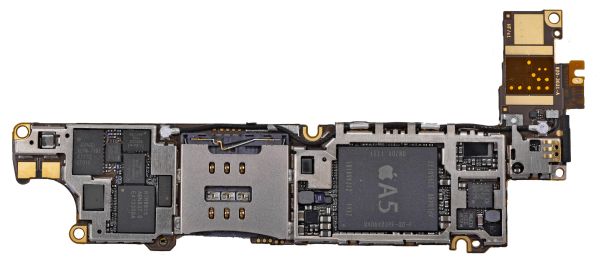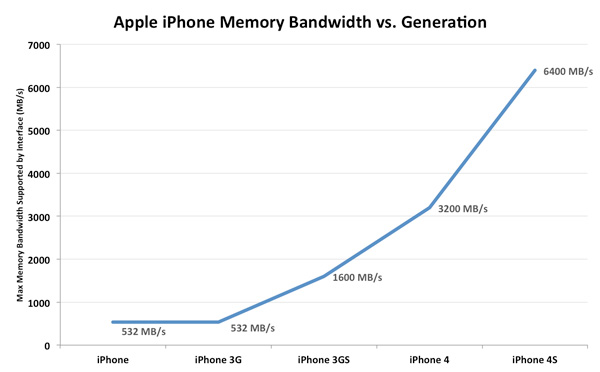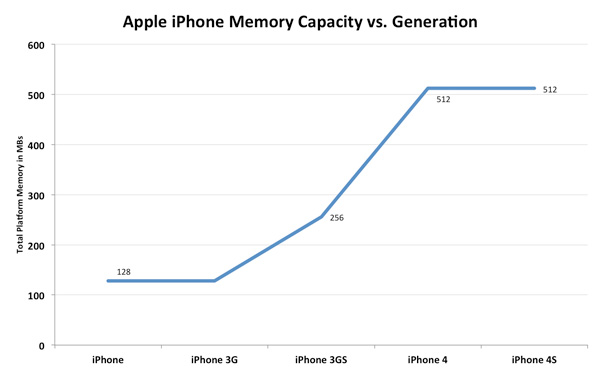Apple iPhone 4S: Thoroughly Reviewed
by Anand Lal Shimpi & Brian Klug on October 31, 2011 7:45 PM EST- Posted in
- Smartphones
- Apple
- Mobile
- iPhone
- iPhone 4S
The Memory Interface
Most SoCs deployed in smartphone designs implement a package-on-package (PoP) stack of DRAM on top of the SoC package. As its name implies, PoP refers to the physical stacking of multiple packages and not layering of raw die. The SoC is typically the lowest level with its memory bus routed to pads on the top of the package. A DRAM package is then stacked on top of the SoC. Avoiding having to route high-speed DRAM lines on the PCB itself not only saves space but it further reduces memory latency.

An example of a PoP stack
The iPhone has always used a PoP configuration for its SoCs and Apple has always been kind enough to silkscreen the part number of the DRAM on the outer package of the SoC. In the past we've seen part numbers from both Samsung and Elpida on Apple SoCs. As both companies can provide similarly spec'd DRAM it makes sense for Apple to source from two suppliers in the event that one is unable to meet demand for a given period.

iPhone 4 mainboard, courtesy iFixit
If we look at iFixit's teardown of the iPhone 4 we see the following DRAM part number: K4X4G643G8-1GC8. Most DRAM vendors do a pretty bad job of providing public data about their part numbers used in chip stacks, so we have to do a little bit of inferring to figure out exactly what Apple used last generation.
The first three characters tell us a bit about the type of DRAM. The K means it's memory, the 4 tells us that it's DRAM and the X tells us that it's mobile DDR (aka LPDDR). The next two characters tell us the density of the DRAM, in this case 4G is translated literally to 4Gbit or 512MB. Characters 6 and 7 are also of importance - they tell us the DRAM organization. Samsung's public documentation only tells us that 16 refers to a 16-bit interface and 32 here would mean a 32-bit interface. Based on that we can safely assume that the 4Gbit DRAM on the A4 is 64-bits wide. In the mobile world a 32-bit interface typically refers to a single channel, which confirms the A4's DRAM interface is two 32-bit channels wide.
The last two characters in the part number, C8, tell us the source clock frequency of the DRAM. Samsung's datasheets tell us that C8 corresponds to a 5ns cycle time with a CAS latency of 3 clocks. Taking the inverse of that gives us 200MHz (frequency = 1 / clock period). Remember, we're talking about double data rate (DDR) SDRAM so data is transferred at both the rising and falling edges of the clock, making the effective data rate 400MHz.
All of this tells us that the iPhone 4's A4 SoC has a 64-bit wide LPDDR1 memory interface with a 400MHz data rate. Multiply all of that out and you get peak theoretical bandwidth of 3.2GB/s. DDR memory interfaces are generally 80% efficient at best so you're looking at a limit of around 2.5GB/s. To put this in perspective, the A4 has as much memory bandwidth as the original AMD Athlon 64 released in 2003.
iPhone 4S mainboard, courtesy iFixit
With the A5 Apple definitely stepped up the memory interface. Once again we turn to iFixit's teardown of the iPhone 4S to lift that oh-so-precious part number: K3PE4E400B-XGC1.
The K once again tells us we're dealing with Samsung memory, while the 3P reveals there are two mobile DDR2 with 4n prefetch (aka LPDDR2-S4) DRAM die on the package. Why not a 4 this time? Technically the 4 refers to a discrete DRAM while the 3 implies a DRAM stack, obviously both are stacked DRAM so I'm not entirely sure why there's a difference here. Each of the next two E4s tell us the density of the two DRAM die. Samsung's public documentation only goes up to E3 which corresponds to a 1Gbit x32 device. Given that we know the A5 has 512MB on-package, E4 likely means 2Gbit x32 (256MB 32-bit). There are two E4 die on package which makes up the 512MB 64-bit DRAM stack.
Once again the final two characters reveal the cycle time of the DRAM: 2.5ns. The inverse of 2.5ns gives us a 400MHz clock frequency, or an 800MHz data rate (source clock frequency is actually 200MHz, but with a 4n prefetch we can transfer at effectively 800MHz). Peak bandwidth to the A5 is roughly double that of the A4: 6.4GB/s. This is as much memory bandwidth as AMD's Athlon 64 platform offered in late 2004, just 7 years later and in a much smaller form factor.
The doubling of memory bandwidth requires a sufficiently large workload to really show it. We see this in Geekbench's memory bandwidth results where the A5 doesn't appear to offer any more bandwidth than the A4 in all but one of the tests:
| Memory Bandwidth Comparison - Geekbench 2 | ||||
| Apple iPhone 4 | Apple iPhone 4S | |||
| Overall Memory Score | 593 | 700 | ||
| Read Sequential | 318.7 MB/s | 302.3 MB/s | ||
| Write Sequential | 704.9 MB/s | 809.2 MB/s | ||
| Stdlib Allocate | 1.55 Mallocs/sec | 1.55 Mallocs/sec | ||
| Stdlib Write | 1.25 GB/s | 2.54 GB/s | ||
| Stdlib Copy | 724.5 MB/s | 490.1 MB/s | ||
| Overall Stream Score | 280 | 281 | ||
| Stream Copy | 413.5 MB/s | 396.4 MB/s | ||
| Stream Scale | 313.3 MB/s | 317.4 MB/s | ||
| Stream Add | 518.0 MB/s | 527.1 MB/s | ||
| Stream Triad | 363.6 MB/s | 373.9 MB/s | ||
Memory bandwidth tests are extremely sensitive to architecture optimizations, particularly for single threaded tests like these so I wouldn't read too much into the cases where you see no gains or a drop.
The increase in raw memory bandwidth makes a lot of sense. Apple doubled the number of CPU cores on the A5, with each one even more bandwidth hungry than the single A4 core. The 4x increase in GPU compute combined with an increase in clock speeds give the A5 another big consumer of bandwidth. Add things like 1080p video capture and the memory bandwidth increase seems justified.
Looking back at the evolution of the iPhone's memory interface gives us an idea of just how quickly this industry has been evolving. Back in 2007 the original iPhone debuted with a 16-bit wide LPDDR-266 memory interface connected to a meager 128MB of DRAM. The 3GS delivered a huge increase in memory bandwidth by doubling the interface width and increasing the data rate to 400MHz. Scaling since then has been even more dramatic:
Memory capacity on the other hand has seen more of a step-function growth:
By using a mobile optimized OS Apple has been able to get around large memory requirements. The growth pattern in memory size partially illustrates the lag between introducing faster hardware and developers building truly demanding applications that require that sort of performance. Apple was able to leave the iPhone 4S at 512MB of RAM because the target for many iOS apps is still the iPhone 3GS generation. Don't be surprised to see a move to 1GB in the next iPhone release (we won't see 768MB due to the dual-channel memory requirement) as the app developer target moves to 512MB.













199 Comments
View All Comments
doobydoo - Friday, December 2, 2011 - link
Hardware wise, the difference between the iPhone 4S CPU/GPU combination and Android competitors, is huge.If you want the best performance, I don't see any other way to turn.
As for the software, I like most users would happily use Android or iOS - they've largely converged anyway.
name99 - Friday, November 4, 2011 - link
"If you had a 4 already your just a "moop" if you upgraded to one of these!"OK, so most US customers on on a 2yr plan. Upgrading for them is impractical, if for no other reason then for carrier reasons. And then you are COMPLAINING that Apple produced an upgrade that (in your eyes) gives them no reason to upgrade???
What exactly is your problem? You're like someone who goes to a restaurant and complains "the food sucks --- and the portions are too small".
dennykins - Tuesday, November 1, 2011 - link
Hey! I have that "Introduction to Modern Optics" book too! Pretty old, but still relevantname99 - Tuesday, November 1, 2011 - link
"It is admittedly curious that Apple hasn’t decided to make some other larger change to distinguish the 4S from the other two"There was, of course, also precious little visual change between iPhone, iPhone3G and iPhone 3GS. Likewise for plenty of other upgrades across the Apple line in the last ten years. I don't know why Anand thinks it's strange. For YEARS Apple has made the point that you buy an iMac --- and you get the what Apple thinks an iMac should be today. You don't buy an iMac XV371. You don't buy an iMac 7. You don't buy an iMac 20011. You buy an iMac --- which may or may not look like its predecessor, which may or may not have last been updated three, six or
nine months ago.
It's obvious that Apple wants to bring that same mindset to phones (and iPads). Screwing with people's expectations of an update in July was simply the first step in breaking the mindset of a particular schedule for upgrades. Of course there are issues that make it more difficult to do this cleanly, for example carrier involvement and the ridiculous subsidized pricing model --- which means that Apple has reason, at least for now, to keep older models around. But there are obvious advantages to Apple in switching to this model, including
- not being forced to release SW too soon. I think we'd all agree iOS5 was released under pressure, and that iOS 5.1 will be the release 5.0 should have been.
- Apple's been able to ignore pressure from a stream of constant Android updates for the past two years, but at some point annual upgrades may just be too slow. At that point it would be nice to have the option of minor upgrades (cf the recent PowerBook Pro upgrades), say boosting the CPU from 800 MHz to 1GHz, without it being a big deal --- something to shut up the crowd that looks at specs, while being ignored by the mass audience that does not care about specs and doesn't want Apple talking about them.
Not that this will stop haters from claiming that "people buy iPhones for fashion"....
KPOM - Tuesday, November 1, 2011 - link
Good observation about the upgrades. Yes, it's entirely possible we'll see minor spec bumps as the iPhone has become a staple of Apple's product line. We don't notice all the the upgrades in the Android world (how many people know or even care about the differences between the Galaxy S, Galaxy S II, and Galaxy S II Skyrocket ?), partly because they happen all the time.Also, Apple has never been a company to change the design simply for the sake of change. They tweak a design until they "get it right," but then stick with it a while. This year's MacBook Air, for instance, is a big update from last year's (Core i5/i7, backlit keyboard, 4GB RAM standard on most models), but they didn't change the external design. It's still selling extremely well and received good reviews. I think it's the same with the iPhone. The 4S has some significant improvements, from the faster processor, better camera, and better antenna.
name99 - Tuesday, November 1, 2011 - link
I'm glad you guys adopted my suggestion to report how snappy a phone feels, based not only on CPU benchmarks but also on the speed of flash, and things like the launch time of apps.In the spirit of constant complaint that is the web, can I now ask that you continue to do this for all future phones, not just iOS devices.
Yes, you have fanboi readers who care only about how wonderful their platform is; but you do also have a number of honest readers who are genuinely interested in things like how the speed of flash (including the speed of SD flash) varies across devices, and how launch times (for comparable apps) vary --- which, of course, depends on both HW and also SW/OS decisions.
Drasca - Tuesday, November 1, 2011 - link
There's a small typo that I'm surprised no one else has caught. Perhaps I am the only one that cares enough about this particular subject enough to. On the last page, 4th to last paragraph, we see:"we’ll hopefully see the technology mature into something more like what years of science fiction moves have promised us."
I believe you mean movies here.
I caught it in particular because I've been discussing amongst my friends how modern technology is the future promise of older science fiction. Oh gosh gee wiz, we have instant mobile communication across the globe, including video! We talk into our portable devices and they think for us. These devices are an extension of ourselves. In a way, we've become like the borg in that we're connected to community at large. Facebook is a form of hive mind group consciousness. Heck, we can track each other near-instantaneously and some folk are vividly aware of each other's locations.
These are interesting times, and what has only previously been explored as supposition has become reality.
I still want my flying cars and teleporters. Also, Holodecks and the AI behind it. Plus, the bridge of the starship enterprise D with its big comfy captain's chair and massive screen.
anishannayya - Wednesday, November 2, 2011 - link
If you want an iPhone, you really don't have a choice. Either you get the 4S or go find an Android phone.shashank7040 - Wednesday, November 2, 2011 - link
Asus Eee Pad being the first tablet With Slide out QWERTY........http://goo.gl/B4rJUthevibenow - Wednesday, November 2, 2011 - link
Check out our review of the Iphone 4shttp://www.youtube.com/watch?v=35v1kkaPM9s